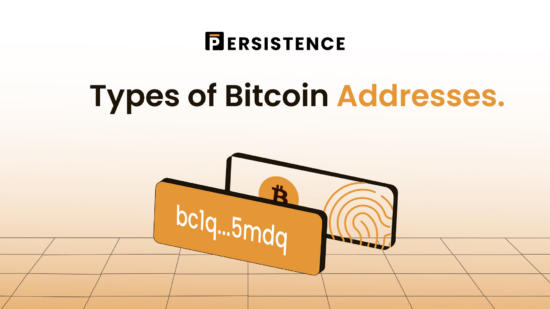Since its inception in 2009, Bitcoin has undergone significant transformations to enhance security, scalability, and user experience. One key aspect of this evolution is the development of various Bitcoin address formats, which have continuously improved to support more efficient and secure transactions.
Each format reflects network protocol advancements, aiming to improve transaction efficiency, reduce fees, and introduce new functionalities. This blog dives into the different types of Bitcoin addresses, their historical context, supported wallets, and applications, providing a thorough understanding for our readers.
Legacy Addresses (P2PKH)
Satoshi Nakamoto introduced the original Bitcoin address format, Pay-to-Public-Key-Hash (P2PKH), with Bitcoin’s launch in 2009. These addresses are easily recognizable, starting with the digit ‘1’.
Example: 1A1zP1eP5QGefi2DMPTfTL5SLmv7DivfNa (Only a reference)
- To generate a P2PKH address, one first creates a private key and then derives a public key using elliptic curve multiplication.
- The public key undergoes a SHA-256 hash, followed by a RIPEMD-160 hash, resulting in the public key hash.
- The system prefixes this hash with a version byte (0x00 for mainnet) and appends a checksum after performing a double SHA-256 hash.
- The final step involves encoding this data using Base58Check, producing the familiar address format.
P2PKH addresses facilitate straightforward transactions by allowing users to send Bitcoin to a hash of the recipient’s public key, enhancing security and reducing transaction data size. However, as the network grew, limitations such as larger transaction sizes and higher fees became apparent, leading to the development of more efficient address formats.
Most Bitcoin wallets support P2PKH addresses, including popular options like Bitcoin Core, Electrum, and hardware wallets like Trezor and Ledger.
Users can generate a P2PKH address by creating a new wallet or selecting the legacy address format within their wallet’s settings.
Pay-to-Script-Hash Addresses (P2SH)
To introduce more complex transaction capabilities, Pay-to-Script-Hash (P2SH) addresses were proposed in BIP 16 and implemented in 2012. These addresses start with the digit ‘3’ and enable functionalities like multi-signature transactions and conditional spending.
Example: 3J98t1WpEZ73CNmQviecrnyiWrnqRhWNLy (Only a reference)
- In P2SH, instead of paying directly to a public key hash, the sender pays to the hash of a redeem script.
- This redeem script can specify various conditions for spending the funds, such as requiring multiple signatures.
- The process involves hashing the redeem script using SHA-256 and RIPEMD-160, prefixing it with a version byte (0x05 for mainnet), adding a checksum, and encoding the result in Base58Check.
P2SH addresses enhance Bitcoin’s scripting capabilities by allowing the recipient to define complex spending conditions. This flexibility supports features like multi-signature wallets, where multiple private keys are required to authorize a transaction, and time-locks, which restrict spending until a specified time. P2SH also facilitated the adoption of Segregated Witness (SegWit) through Nested SegWit addresses, providing backward compatibility with older wallets.
Many modern wallets support P2SH addresses, including wallets like Ledger and Trezor. Users can typically select P2SH as their preferred address type within the wallet’s settings or during wallet creation.
Segregated Witness Addresses (SegWit – P2WPKH and P2WSH)
Segregated Witness (SegWit), activated in 2017 via BIP 141, was a significant protocol upgrade aimed at improving scalability and fixing transaction malleability. SegWit introduced new address types: Pay-to-Witness-Public-Key-Hash (P2WPKH) and Pay-to-Witness-Script-Hash (P2WSH), commonly represented using the Bech32 encoding scheme.
Example: bc1qw508d6qejxtdg4y5r3zarvary0c5xw7kygt080 (P2WPKH)
- For P2WPKH addresses, the public key is hashed using SHA-256 and RIPEMD-160 to produce the public key hash.
- This hash is then combined with a witness version (0x00) and encoded using the Bech32 encoding scheme, resulting in an address that starts with ‘bc1q’.
- P2WSH addresses follow a similar process but involve hashing a redeem script instead of a public key.
SegWit addresses offers several advantages, including reduced transaction sizes, leading to lower fees, and the elimination of transaction malleability, which is crucial for developing second-layer solutions like the Lightning Network. The Bech32 encoding also improves error detection and makes addresses case-insensitive, enhancing user experience.
Support for SegWit addresses has grown over time, with many wallets now offering compatibility. Wallets like Electrum, Wasabi, and hardware wallets such as Ledger and Trezor support SegWit addresses. Users can generate a SegWit address by selecting the appropriate option in their wallet’s settings.
Taproot Addresses (P2TR)
Taproot, introduced through Bitcoin Improvement Proposal 341 (BIP 341) and activated in November 2021, represents one of the most significant upgrades to Bitcoin in recent years. It introduced a new address type called Pay-to-Taproot (P2TR), which enhances privacy, efficiency, and smart contract functionality while keeping Bitcoin’s core principles of decentralization intact.
Taproot addresses begin with ‘bc1p’ (distinguishing them from SegWit’s Bech32 addresses that start with ‘bc1q’).
What Taproot Solves
Before Taproot, Bitcoin transactions had several efficiency and privacy limitations:
- On older address types (P2SH & P2WSH), multi-signature transactions looked different from standard transactions on-chain. This meant that anyone scanning the blockchain could identify multi-sig transactions, making them less private.
- Transactions involving multiple signatures (e.g., 2-of-3 multisig wallets) required more data, increasing transaction size and fees.
- Unlike Ethereum, Bitcoin’s smart contract functionality was limited and inefficient, making it harder to create complex transactions.
Taproot solves these issues by making every transaction, whether a simple payment, multisig, or complex smart contract look the same on-chain. This significantly improves privacy, efficiency, and scalability.
EVM-Compatible Bitcoin Addresses (0x… Ethereum-Style)
While Bitcoin itself does not natively support smart contracts, the rise of Bitcoin Layer 2 solutions has introduced Ethereum Virtual Machine (EVM) compatibility. This means some Bitcoin-based networks allow users to interact with BTC through Ethereum-style (EVM) addresses, which start with 0x—the same format as Ethereum and other EVM chains.
Why Bitcoin L2s Use EVM Addresses
Bitcoin L2s aims to expand Bitcoin’s utility beyond its original purpose as a store of value. By supporting Ethereum-style addresses, these networks allow:
- BTC is to be used in DeFi protocols (lending, borrowing, swaps).
- Bitcoin-native assets to interact with smart contracts.
- Easier integration with wallets like MetaMask, OKX, and Trust Wallet.
- Seamless bridging of BTC across different networks.
Popular Bitcoin Layer 2 Networks Using EVM Addresses
As of 2025, several Bitcoin L2s are leveraging EVM compatibility:
- Rootstock (RSK): A Bitcoin sidechain enabling smart contracts while using BTC as gas.
- Stacks (via sBTC & DLCs): Uses a unique mechanism to bring programmability to Bitcoin.
- Merlin Chain: An EVM-compatible L2 for Bitcoin-based dApps.
- BOB (Build on Bitcoin): A hybrid rollup that supports Bitcoin-native assets in an EVM environment.
- Bitlayer & BEVM: Bringing Ethereum’s ecosystem to Bitcoin L2 scaling solutions.

Source: Bitcoin Ecosystem.
Which Type Of Bitcoin Address Is The Most Popular?
The Bitcoin address type distribution chart highlights a clear shift towards SegWit (P2WPKH) addresses, which now dominate Bitcoin transactions, as shown by the overwhelming purple section. This reflects widespread adoption due to lower fees and improved efficiency.
Meanwhile, Taproot (P2TR) usage is gradually increasing (blue section), indicating growing support for enhanced privacy and smart contract capabilities. Legacy formats (P2PKH, P2SH) continue to decline, confirming that users are transitioning to more advanced address types.
Multisig and other niche formats remain present, but their share is relatively small. Overall, the chart reinforces Bitcoin’s steady move toward scalability, lower-cost transactions, and better privacy through newer address formats.

Source: Dune Analytics
About Persistence One
Persistence One is building the BTCFi Liquidity Hub, enabling fast, near zero-slippage swaps for XPRT, BTC-variants, and BTCfi tokens on Persistence DEX.
BTCFi’s rapid growth has created multiple BTC-related assets, making fragmentation a big challenge. Persistence One will provide a single liquidity hub, simplifying value transfer across the Bitcoin ecosystem.
Twitter | LinkedIn | Telegram | YouTube | Reddit | [email protected]





